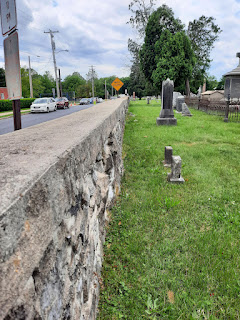 |
| The Molly Pitcher Monument |
Here's her story: During the American Revolution, Mary Hays
followed her husband, William Hays, to war, as a large number of women did. In
those days, women would follow the army to care for their soldier family members in
a variety of ways, like cooking, sewing, laundry, or assisting with medical
care. One other task these volunteers provided was bringing water to the
soldiers during training, or even during battle. These women earned the
nickname “Molly Pitcher.” Molly is a way of saying Mary, and Pitcher of course
is for the pitcher of water they’d carry.
 |
| The current monument is from 1916. |
Legend has it that during the battle she was seen working
with the gun’s crew by General George Washington. The General supposedly congratulated
her and made her a sergeant as a reward for her bravery. None of that can be
proven, although Mary reportedly went by the nickname “Sergeant Molly” for the
rest of her life. However, in 1830 a war veteran’s narrative was published that
described the incident of a woman taking over for her husband on an artillery piece during the Battle of Monmouth.
In it, the writer says that a British cannon ball passed between the woman’s
legs, tearing through her skirt but leaving her unharmed.
After the battle, Mary Hays and her husband returned to their
home in Carlisle, Pennsylvania. William Hays died in 1786. Mary later married
again, to a man named John McCauley. In 1822, Mary was granted a pension by the
state of Pennsylvania for her service. Mary died in 1832 and is buried in the
Old Public Graveyard as Mary McCauley. The current Molly Pitcher monument was
erected in 1916.
 |
| Union troops were behind this wall during a Civil War skirmish. |
If you ever get the chance to walk around Carlisle, please
do. Lots of history there from the Revolution to the Civil War. Take a look at
the Old Public Graveyard on South Street at Bedford. It’s an interesting place,
with the oldest burial from 1757. The east wall protected approximately 200 Union
soldiers when Jeb Stuart’s Confederate cavalry raided Carlisle during the Gettysburg Campaign. They traded shots with Confederate skirmishers who were
deployed in what would become Letort Park, on the other side of the creek. But
that’s a story for a future post.

